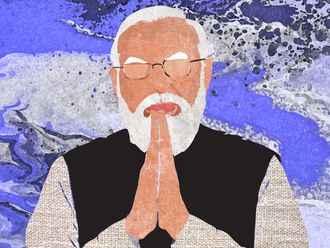A few years ago, I visited my junior school in Bengaluru shortly before it closed down. Seeing the little men in their uniforms, I felt a stab in my chest when I saw how young they were, how tiny they were. I thought back to the teacher who, in the euphemism of the time, “used the ruler”: physical assault with an object.
When she’d enter class, our eyes would go straight to the shiny wooden foot-long ruler she always carried. It wouldn’t be long before she found an excuse to start beating her students on their palms, knuckles or shins.
For more serious crimes, she would turn the ruler on its edge, the cracking sound as it hit the knuckles of a seven-year-old boy clearly audible across the room. Her classes were studies in terror, as she’d walk up and down the rows looking for a reason, any reason, to beat us.
Revisiting this memory more recently, I thought about what a scarred, even deranged person she must have been to beat such small children so savagely. The principal of the school was a kindly and beloved nun, but here’s a question I’ve never heard anyone ask: why did she allow these beatings in her school?
Interestingly, I had figured out a way to, sometimes at least, avoid a beating. If you placed a shiny new object on your desk, such as a colourful eraser or a fancy propelling pencil, the teacher would pick it up and examine the object, turning it over and over in her hands, always looking as if she was contemplating stealing it. Then she’d return the item to the desk and walk on, leaving you unmolested that day.
Talismans
I remember looking frantically through my pencil case for talismans, and once, not finding anything, desperately put out the pencil shaving flowers I’d saved. It was worth a try. They didn’t work. I must have messed up my Hindi dictation, and down came that ruler.
I’m writing about this now because I’m surrounded by friends and family with young children, and I can’t imagine a situation where strangers regularly hit these kids with objects, causing their hands to swell and skin to go red. Of course, talking to teachers these days, the pendulum has swung so far in the opposite direction that they are scared to administer correction of even the mildest kind, because a tribe of angry parents will descend on the school.
With luck, the next step in this process is when the student body itself has a voice. In the US, I read with wonder the stories of students who protest or subvert unfair policies at their school. It takes a lot of maturity for a society to give children a public voice.
I saw a small version of this recently at my apartment housing complex in Bengaluru. Children playing in the common areas bring up a number of issues: noise, encounters with cars, balls hitting windows or people. The association convened a meeting, and had a panel of the children to talk about this from their point of view. They did not have adults speak on the children’s behalf, nor did they decide from on high what was best for them.
I was proud to see this happen, and took a moment to think about the children, now grown, who’d see a wooden ruler and instead of thinking “straight lines, geometry, mini cricket bat”, would think “pain, torture, fear”. Sure, we might be a little oversensitive these days, but we should be proud that those days of abuse are gone.
Gautam Raja is a journalist based in Los Angeles, USA.











